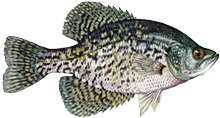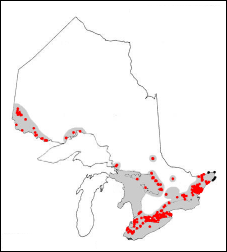Black Crappie
Information about the Black Crappie (Pomoxis negromaculatus), a cool-water fish native to Ontario.

Species illustration (Illustration Credit: U.S. Wildlife Service)
What it looks like
- small, deep-bodied fish
- silver with blue or green iridescence and irregular mosaic of distinct black blotches
- 7 to 8 dorsal fin spines
- 6 to 7 anal fin spines
- large mouth extends below middle of eye
Size
- length: 18-25 centimetres (7-10 inches)
- weight: 0.23–0.45 kilograms (0.5–1.0 pounds)
- Ontario record: 1.7 kilograms (3.8 pounds)
Similar fish
Where it is found

Species distribution map (modified from Mandrak and Crossman, 1992)
Range
- found throughout southern Ontario, including protected bays of the southern Great Lakes and in northwestern Ontario
- use Fish ON-Line, an interactive mapping tool, to find specific lakes and rivers
Habitat
- warm, clear, vegetated lakes, ponds and rivers
- little current
- open areas adjacent to cover
- access to deeper water in winter and summer
Find a fishing spot with Fish ON-Line
Angling tips
- move in schools
- bite during the day, especially during overcast weather
- bite most often during low light periods (dawn and dusk)
- best fishing in April and early May as the ice clears, and crappie follow schools of bait into warmer, shallow water
- eyes are positioned to see upward, so work bait slightly above them
- use light spinning or fly-fishing tackle and 6-pound or less line
Common baits
- spinners
- panfish jigs
- small crankbaits
- streamer flies
- small live minnows, nymphs
Updated: January 04, 2023
Published: July 18, 2014